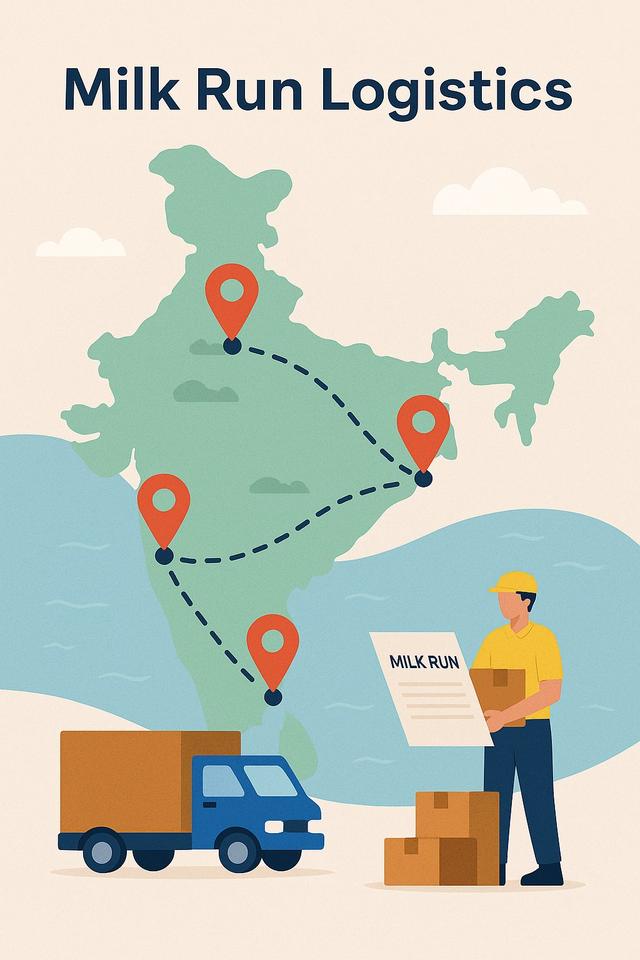Milk Run Logistics: Efficient Route Planning for Supply Chains
India's complex geography and high-density urban-rural mix pose significant challenges for efficient logistics. Whether it's e-commerce deliveries in Delhi, auto parts shipments in Pune, or FMCG distribution in Tamil Nadu, routing matters. One of the most cost-efficient models gaining traction in Indian supply chains is milk run logistics — a multi-stop, route-optimized delivery approach inspired by dairy collection systems. This article explores how milk run logistics works, its relevance to Indian shippers, route planning best practices, implementation steps, and how Cogoport supports smarter logistics execution.

What is Milk Run Logistics?
Milk run logistics refers to a transport model where a single vehicle picks up or delivers goods at multiple stops in a predefined sequence before returning to its origin or base. The term originates from traditional milk collection routes where dairies dispatched trucks to collect milk from multiple farms. In supply chains, it’s used for inbound or outbound movement of goods to reduce transportation costs, improve vehicle utilization, and streamline delivery cycles.
Why It Matters in India
With soaring last-mile costs, underutilized trucks, and rising delivery expectations, Indian logistics needs smarter, leaner delivery models. Milk runs offer a solution, especially in:
- Automotive hubs (e.g. Pune, Chennai): Parts picked up from multiple suppliers in one run
- E-commerce distribution: Clustered delivery to high-density pin codes
- SME exporters: Consolidated shipments from smaller factories to port or ICD
Benefits of Milk Run Logistics
- Cost savings: Fewer empty returns, shared vehicle cost across shipments
- Higher vehicle utilization: Optimized cubic volume or weight per trip
- Reduced carbon footprint: Fewer kilometers per unit delivered
- Better inventory control: Frequent smaller deliveries reduce carrying cost
- Improved delivery reliability: Standardized, time-bound routes
Types of Milk Run Models
- Single vehicle, fixed route: One vehicle makes all stops in sequence and returns to base.
- Multi-vehicle coordination: Multiple trucks operate in parallel across fixed zones.
- Hub-and-spoke + milk run: Milk run to regional DC or hub; final-mile via another carrier.
- Inbound vs Outbound: Supplier pickup vs delivery to multiple buyers or retail points.
How to Plan a Milk Run Route
- Pin code or location clustering: Group stops that are geographically proximate
- Demand mapping: Assess volume/frequency per stop to balance loads
- Time windows: Align deliveries with receiver availability (e.g. factory working hours)
- Vehicle capacity constraints: Adjust for max weight, pallet count, stack height
- Use routing software or APIs: Solve Vehicle Routing Problems (VRP), optimize sequence
- Incorporate real-time visibility: Reroute for traffic, delays, no-entry windows
Cost vs Time: Is Milk Run Always Cheaper?
Milk runs are most efficient when stops are close together and volumes are regular. However, they may not suit:
- Very time-sensitive cargo requiring direct dispatch
- Low-volume destinations far from route (low density)
- Unpredictable demand / last-minute order changes
Still, when route density is high and coordination is tight, milk runs can reduce per-unit delivery cost by 20–40%.
Implementing Milk Run Logistics in India
- Pilot in one corridor: Choose a region with good order consistency and proximity
- Engage suppliers/buyers: Align on pickup/drop slots and SLAs
- Select a transport partner: Prefer digital 3PLs with tracking, routing capability
- Define fixed routes: Start with static routing, evolve to dynamic adjustments
- Digitize documentation: POD, e-invoice, e-Waybill via app reduces manual delay
- Review & refine weekly: Check route adherence, delays, customer feedback
How Cogoport Helps With Milk Run Execution
Cogoport’s logistics platform offers routing tools, load pooling, and visibility dashboards ideal for milk run models:
- View multi-stop delivery status on a single map
- Real-time truck tracking with ETAs at each stop
- Digitally capture PODs at every drop
- Coordinate pickups from multiple vendors to a port/ICD
- Automate routing via API with your ERP / WMS
Get started with Cogoport milk run logistics

FAQs
Can milk runs work for export shipments?
Yes — exporters often use milk runs to collect from multiple manufacturing units and consolidate at the port.
What’s the ideal number of stops per milk run?
4–6 stops is common; depends on geography, time window, and vehicle capacity.
Do milk run routes need to be fixed?
Initially yes — fixed routes help establish baseline performance. Dynamic routing is possible later via GPS data.
Can I run milk runs with third-party vehicles?
Yes — many 3PLs or aggregators (like Cogoport) enable this with real-time tracking support.
How do I manage delays or cancellations?
Use real-time alerts and fallback SOPs — e.g. skip stop, reschedule, alternate route if needed.
What industries use milk runs most in India?
Auto, FMCG, pharma, e-com, electronics, ceramics — wherever clustered demand exists.
Quick search: Discover rates in minutes
Check live schedules and rates on popular lanes, then book with CogoAssured capacity.
Updated: October 2025
Disclaimer: This article provides general information and is not legal advice.



